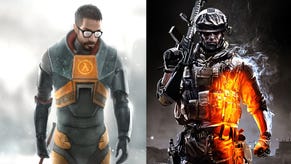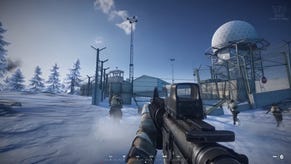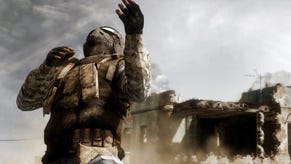Andy McNab and Battlefield 3
"These guys know what they're doing."
Battlefield earned its stripes as a multiplayer game. Fast forward 11 years and Battlefield, now promoted as the contender to the colossal Call of Duty, will have to exhibit similar skill at telling a story. Who better to hire as help, thought Battlefield 3 developer DICE, than best-selling author and former SAS member Andy McNab.
McNab, a pseudonym, shot to fame for writing Bravo Two Zero, his account of a failed Gulf War SAS patrol. He's written more books based on his own experiences since, as well as fiction and an autobiography. McNab also spent time in Hollywood advising on the use of weapons and military manoeuvres, and worked with Michael Mann and the actors on Heat. Now, his silhouetted self has turned to games.
Andy McNab is co-writing a book called Battlefield 3: The Russian to accompany the game. The book fleshes out game character Dmitri "Dima" Mayakovsky. But McNab's influence on Battlefield 3 doesn't end there; he's been working with DICE for just under a year, ensuring that the story works, the game looks believable, and that the actors behave like real soldiers.
Eurogamer talked to Andy McNab.
Working on the game on a number of different levels. I was asked to look at the script, and I was looking at motivations and justifications for things to happen. It was more question and answer than a creative process on that.
"There's a nine year-old today, and when he comes back from whatever he's doing he can turn the telly on and he can watch rape and murder at half-past six at night."
And then sitting down with the teams doing different aspects of different levels and looking at the aesthetics, trying to get it looking right. You can look at a catalogue of tanks online, but actually what we forget is that for the tank crews that's their home, they live in it, so they personalise it. It's trying to give it that feel of being right.
Then looking at the tactics, what people are doing on the ground and the reasons why they're doing it, and transferring it into the motion capture studio. Actors want to know why they're doing something in a certain way and why they're saying things. Soldiers' dialogue is always progressive and positive, there's no "what we're trying to do". It's "what we'll do is..." - it's all that positive stuff. Trying to talk about that and why that happens, so when the actors do their two or three lines of dialogue they've got that background to it, as well as holding the weapons in a realistic way so it looks like they've been using them for years.

Certainly, on the tank attack aspects. I've already talked about tank crews, how they live and how everybody's trying to plumb in their iPhones and all that stuff. But when they're going through the compound, the big desert fortification where they build up the sand to make it like a fort complex, it's an exact replica of one that is on the Iraq-Iranian border.
You get these big, battalion-sized fortifications. It looks like some medieval embankment. So we're sitting down looking at all the bits and pieces coming out about the major tank attack and looking at the fortifications, and I remembered that about four years ago I was flying along the border with the MOD, because I do these trips for the Ministry of Defence, you know, the Brits. And we flew over these [fortifications] that we used for 10 years in the war between Iraq and Iran. And as you do I just took some [pictures]. I thought ah, you know what, I've got some pictures. When I got back to the UK I'm trolling through the lap top trying to find it and I sent the pictures back [to DICE].
So what happened is you've got an exact replica of one of the fortifications that's on the Iraq-Iranian border. I wasn't quite sure if it was going to be used, but the next time I come [to DICE] it's there, in the game. That was really good.









